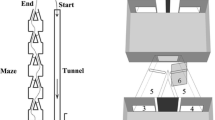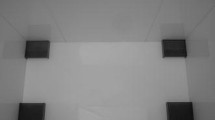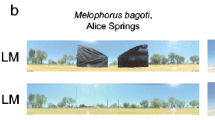Summary
-
1.
An open- and closed-loop study of the way ladybirds,Coccinella septempunctata, approach vertical posts emphasizes two features of this reflex. First, ladybirds turn preferentially towards close objects, obtaining the necessary distance information from optic flow. Secondly, once an object has been fixated, movement of its image over frontal retina tends to suppress any response to other laterally viewed targets.
-
2.
Recordings were made of the trajectories followed by ladybirds in an open arena which contained a single, vertical post on the floor. Ladybirds often approached and climbed up the post. Many approaches consisted of straight-line segments interrupted by abrupt turns. These turns are either appropriately sized so that the ladybird faces the post after one turn or, more often, they are too small in which case the ladybird's trajectory is a spiral. The gain of the turn (i.e. the ratio of the size of the turn to the size which is needed to fixate the post) increases slightly as the insect approaches the post.
-
3.
The ladybirds' preference for close objects was examined further on a Y-maze. Insects placed on the trunk of the maze ran towards the fork and down one arm. Each arm of the maze led to a rectangle. Rectangles were placed at various distances from the fork. Their size was adjusted so that viewed from the fork they all subtended 18° horizontally and 63° vertically. Ladybirds chose predominantly the arm which led to the closer rectangle.
-
4.
Open-loop tests indicate that this preference for close objects is caused by the pattern of optic flow resulting from the ladybirds' normal forward locomotion. Insects were fixed in front of a computer screen and carried a small ring which they rotated beneath them. Any attempted turn was manifest in a turn of the ring in the opposite direction. Turns were regularly elicited by small backward movements of a vertical stripe across the retina, as would occur during forward walking. Forward motion of the stripe over the retina rarely evoked turns. Turns increased in frequency and size as the speed of backward image motion was raised from 3°/s to 70°/s. The largest turns were evoked with the stripe placed at an eccentricity of about 90 degs from the midline. Amplitude dropped as the stripe was positioned further frontally or posteriorly.
-
5.
Approaches to a target were modelled using a saccadic system in which gain varied with distance from the target. This simulation generated spiral trajectories. Thus, the spirals described by a ladybird when it walks towards a post may be a consequence of the way the insect uses motion parallax to restrict its attention to nearby objects.
-
6.
Open-loop turns to a stripe moving over peripheral retina are prevented by the concurrent motion of a stripe viewed by frontal retina. This longrange inhibition means that, once a stripe has been fixated, an insect's attention is less likely to be distracted by objects seen peripherally.
Similar content being viewed by others
References
Collett TS (1978) Peering — a locust behaviour pattern for obtaining motion parallax information. J Exp Biol 76:237–241
Collett TS, Land MF (1978) How hoverflies compute interception courses. J Comp Physiol 125:191–204
Eriksson ES (1980) Movement parallax and distance perception in the grasshopper (Phaulacridium vitatum (Sjöstedt)). J Exp Biol 86:337–340
Goulet M, Campan R, Lambin M (1981) The visual perception of relative distances in the wood-cricket,Nemobius sylvestris. Physiol Entomol 6:357–367
Jander R (1971) Visual pattern recognition and directional orientation in insects. Ann NY Acad Sci 188:5–11
Land MF (1971) Orientation by jumping spiders in the absence of visual feedback. J Exp Biol 54:119–139
Lea JY, Mueller CG (1977) Saccadic head movements in mantids. J Comp Physiol 114:115–128
Mast SO (1911) Light and the behaviour of organisms. Wiley, New York
Reichardt W (1973) Musterinduzierte Flugorientierung. Naturwissenschaften 60:122–138
Rossel S (1980) Foveal fixation and tracking in the preying mantis. J Comp Physiol 139:307–331
Wagner H (1986) Flight performance and visual control of flight in the free-flying housefly (Musca domestica L.). II. Pursuit of targets. Phil Trans R Soc Lond B 312:553–579
Wallace GK (1959) Visual scanning in the desert locustSchistocerca gregaria Forskal. J Exp Biol 36:512–525
Zanker JM, Collett TS (1985) The optomotor system on the ground: on the absence of visual control of speed in walking ladybirds. J Comp Physiol A 156:395–402
Author information
Authors and Affiliations
Rights and permissions
About this article
Cite this article
Collett, T.S. How ladybirds approach nearby stalks: a study of visual selectivity and attention. J. Comp. Physiol. 163, 355–363 (1988). https://doi.org/10.1007/BF00604011
Accepted:
Issue Date:
DOI: https://doi.org/10.1007/BF00604011




